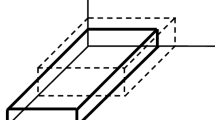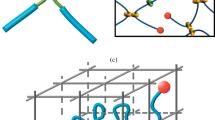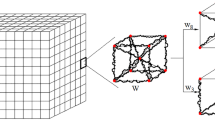Abstract
Network structures of various polymers have significant effects on their mechanical properties; therefore, numerous studies have investigated the constitutive relationship between symmetrical network structures and their rubber elasticity in polymers. However, few studies have focused on asymmetrical network structures in polymers that undergo bond exchange reactions, self-assembly, or mechanochemical coupling—all of which are induced by transition probabilities of chemical bonding processes. In this study, an extended constraint junction and phantom network model is formulated using the tree-growing theory to establish a constitutive relationship between asymmetrical network structures and their rubber elasticity in polymers. A free-energy equation is further developed to explore working principles of configurational transitions on the dynamic rubber elasticity of symmetrical and asymmetrical network structures. The constitutive relationship between dynamic rubber elasticity and symmetrical and asymmetrical network structures has also been proposed for the gels undergoing mechanochemical and hydromechanical coupling. Finally, the effectiveness of this newly proposed tree-growing model has been verified by comparing with the classical affine network model, finite element analysis, and the experimental results of gels reported in literature.
Similar content being viewed by others
References
Sun J Y, Zhao X, Illeperuma W R K, et al. Highly stretchable and tough hydrogels. Nature, 2012, 489: 133–136
Zhang Y H, Cui C Y, Sun Y G, et al. A hyperbranched polymer-based water-resistant adhesive: Durable underwater adhesion and primer for anchoring anti-fouling hydrogel coating. Sci China Tech Sci, 2022, 65: 201–213
Wei Z Z, Dong X, Zhang Y Q. A mechanically robust egg white hydrogel scaffold with excellent biocompatibility by three-step green processing. Sci China Tech Sci, 2022, 65: 1599–1612
Na H, Kang Y W, Park C S, et al. Hydrogel-based strong and fast actuators by electroosmotic turgor pressure. Science, 2022, 376: 301–307
Liu Z, Toh W, Ng T Y. Advances in mechanics of soft materials: A review of large deformation behavior of hydrogels. Int J Appl Mech, 2015, 7: 1530001
Hua M, Wu S, Ma Y, et al. Strong tough hydrogels via the synergy of freeze-casting and salting out. Nature, 2021, 590: 594–599
Arno M C, Inam M, Weems A C, et al. Exploiting the role of nanoparticle shape in enhancing hydrogel adhesive and mechanical properties. Nat Commun, 2020, 11: 1420
Chen G Y, Guo Y, Hsiao S B, et al. Tough, conductive hydrogels with double-network based on hydrophilic polymer assistant well-dispersed carbon nanotube for innovative force sensor. Sci China Tech Sci, 2022, 65: 1160–1168
Hua Y, Xia H, Jia L, et al. Ultrafast, tough, and adhesive hydrogel based on hybrid photocrosslinking for articular cartilage repair in water-filled arthroscopy. Sci Adv, 2021, 7: eabg0628
Wang G, Zhang Q, Wang Q, et al. Bio-based hydrogel transducer for measuring human motion with stable adhesion and ultrahigh toughness. ACS Appl Mater Interfaces, 2021, 13: 24173–24182
Gong J P, Katsuyama Y, Kurokawa T, et al. Double-network hydrogels with extremely high mechanical strength. Adv Mater, 2003, 15: 1155–1158
Zhang X, Wang K, Hu J, et al. Role of a high calcium ion content in extending the properties of alginate dual-crosslinked hydrogels. J Mater Chem A, 2020, 8: 25390–25401
Newham G, Evans S D, Ong Z Y. Mechanically tuneable physical nanocomposite hydrogels from polyelectrolyte complex templated silica nanoparticles for anionic therapeutic delivery. J Colloid Interface Sci, 2022, 617: 224–235
Sun P, Zhang H, Xu D, et al. Super tough bilayer actuators based on multi-responsive hydrogels crosslinked by functional triblock copolymer micelle macro-crosslinkers. J Mater Chem B, 2019, 7: 2619–2625
Gu S, Cheng G, Yang T, et al. Mechanical and rheological behavior of hybrid cross-linked polyacrylamide/cationic micelle hydrogels. Macromol Mater Eng, 2017, 302: 1700402
Sarrigiannidis S O, Rey J M, Dobre O, et al. A tough act to follow: Collagen hydrogel modifications to improve mechanical and growth factor loading capabilities. Mater Today Bio, 2021, 10: 100098
Slawinski M, Kaeek M, Rajmiel Y, et al. Acetic acid enables precise tailoring of the mechanical behavior of protein-based hydrogels. Nano Lett, 2022, 22: 6942–6950
Chen K, Lin Q, Wang L, et al. An all-in-one tannic acid-containing hydrogel adhesive with high toughness, notch insensitivity, self-healability, tailorable topography, and strong, instant, and on-demand underwater adhesion. ACS Appl Mater Interfaces, 2021, 13: 9748–9761
Shibaev A V, Kuklin A I, Torocheshnikov V N, et al. Double dynamic hydrogels formed by wormlike surfactant micelles and cross-linked polymer. J Colloid Interface Sci, 2022, 611: 46–60
Li S, Zhou H, Li Y, et al. Mussel-inspired self-adhesive hydrogels by conducting free radical polymerization in both aqueous phase and micelle phase and their applications in flexible sensors. J Colloid Interface Sci, 2022, 607: 431–439
Yang Y. Graph theory of viscoelastic and configurational properties of Gaussian chains. Macromol Theor Simul, 1998, 7: 521–549
Yang Y, Qiu F, Zhang H, et al. The rouse dynamic properties of dendritic chains: A graph theoretical method. Macromolecules, 2017, 50: 4007–4021
Xiang Y, Zhong D, Wang P, et al. A general constitutive model of soft elastomers. J Mech Phys Solids, 2018, 117: 110–122
Bergström J S, Boyce M C. Deformation of elastomeric networks: Relation between molecular level deformation and classical statistical mechanics models of rubber elasticity. Macromolecules, 2001, 34: 614–626
Flory P J. Theory of elasticity of polymer networks. The effect of local constraints on junctions. J Chem Phys, 1977, 66: 5720–5729
Kloczkowski A, Mark J E, Erman B. A diffused-constraint theory for the elasticity of amorphous polymer networks. 1. Fundamentals and stress-strain isotherms in elongation. Macromolecules, 1995, 28: 5089–5096
Erman B, Monnerie L. Theory of elasticity of amorphous networks: Effect of constraints along chains. Macromolecules, 1989, 22: 3342–3348
Cantwell G T, St-Onge G, Young J G. Inference, model selection, and the combinatorics of growing trees. Phys Rev Lett, 2021, 126: 038301
Rubinstein M, Colby R H. Polymer Physics. New York: Oxford University Press, 2003
Cohen M H, Grest G S. Liquid-glass transition, a free-volume approach. Phys Rev B, 1979, 20: 1077–1098
Dobrynin A V, Carrillo J M Y. Universality in nonlinear elasticity of biological and polymeric networks and gels. Macromolecules, 2011, 44: 140–146
Treloar L R G. The Physics of Rubber Elasticity. New York: Oxford University, 1975
Fried J R. Polymer Science and Technology. New York: Pearson Education Press, 2014
Xiao L, Zhu J, Londono J D, et al. Mechano-responsive hydrogels crosslinked by block copolymer micelles. Soft Matter, 2012, 8: 10233–10237
Huang H, Zhang X, Dong Z, et al. Nanocomposite conductive tough hydrogel based on metal coordination reinforced covalent Pluronic F-127 micelle network for human motion sensing. J Colloid Interface Sci, 2022, 625: 817–830
Xu C, Lee W, Dai G, et al. Highly elastic biodegradable single-network hydrogel for cell printing. ACS Appl Mater Interfaces, 2018, 10: 9969–9979
Shen B, Peng W, Su B, et al. Elastic-electric coefficient-sensitive hydrogel sensors toward sweat detection. Anal Chem, 2022, 94: 1910–1917
Author information
Authors and Affiliations
Corresponding authors
Additional information
This work was supported by the National Natural Science Foundation of China (Grant No. 12172107).
Rights and permissions
About this article
Cite this article
Shi, W., Zhou, J., Lu, H. et al. A tree-growing graphic model for asymmetrical phantom networks in polymeric gels undergoing dynamic mechanochemical coupling. Sci. China Technol. Sci. 67, 558–567 (2024). https://doi.org/10.1007/s11431-023-2430-3
Received:
Accepted:
Published:
Issue Date:
DOI: https://doi.org/10.1007/s11431-023-2430-3




